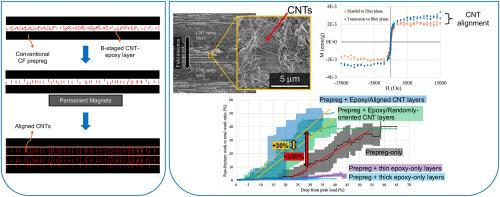使用磁响应碳纳米管将对齐的碳纳米管插入到传统的预浸料基CFRP层叠板的层内区域
IF 9.8
1区 材料科学
Q1 MATERIALS SCIENCE, COMPOSITES
引用次数: 0
摘要
尽管碳纤维增强塑料(CFRPs)由于其优异的面内力学性能而广泛应用于航空航天、汽车、能源等行业,但其面外力学性能却相对较弱。目前用碳纳米管改善面外性能的方法仅限于在常规CFRP层之间添加随机或排列的碳纳米管,或者使用碳纳米管/树脂混合物制成的预浸料在整个CFRP体积中集成随机定向的碳纳米管。即使在这种制造方法中,也缺乏定量表征CFRPs中碳纳米管形态(浓度、排列、分布等)的方法。这项工作通过使用磁响应的ni涂层碳纳米管解决了这两个限制。在制造过程中,通过施加外部磁场,将ni涂层的CNTs通过厚度对齐插入传统的CFRP预浸料中。在距离预浸料界面10s微米的预浸料区域,即Ni-CNTs最初插入的位置,可以观察到整齐的CNTs。通过振动样品磁强计测量,证实了层合板内ni涂层碳纳米管在面外方向的各向异性饱和磁化强度比面内方向大34%。在短梁剪切试验中,与不含碳纳米管的相同CFRP相比,碳纳米管-CFRP表现出更强的峰后延展性。在排列好的CNTs -CFRP中,峰后功与总功的比值比未排列CNTs的CFRP大~ 30%,比未排列CNTs的CFRP大~ 250%,证实了排列好的CNTs在抵抗层间裂纹扩展方面的有益作用。本文章由计算机程序翻译,如有差异,请以英文原文为准。

Insertion of aligned CNTs into the intralaminar regions of conventional prepreg-based CFRP laminates using magnetically responsive CNTs
Although carbon fiber reinforced plastics (CFRPs) are widely used in aerospace, automotive, and energy industries due to their excellent in-plane mechanical properties, they exhibit relatively weak out-of-plane properties. Current methods of improving the out-of-plane properties with CNTs are limited to adding random or aligned CNTs between conventional CFRP plies or integrating randomly oriented CNTs throughout the entire CFRP volume using prepregs made with CNT/resin mixtures. Even in such manufacturing approaches, methods of quantitatively characterizing CNT morphology (concentration, alignment, distribution, etc.) in CFRPs are lacking. This work addresses both limitations by using magnetically responsive Ni-coated CNTs. The Ni-coated CNTs were inserted, with through-thickness alignment, into conventional CFRP prepregs by applying external magnetic fields during manufacturing. Aligned CNTs were observed in regions of the prepreg 10s of microns away from the prepreg interface, where the Ni-CNTs were originally inserted. The Ni-coated CNTs within laminates were confirmed to be aligned based on anisotropic saturation magnetization 34 % larger in the out-of-plane direction versus the in-plane direction, as measured with a vibrating sample magnetometer. In short beam shear testing, the CNT-CFRPs exhibited a more ductile post-peak behavior in comparison to the same CFRP without CNTs. The ratio of the post-peak work to total work in the aligned CNT-CFRPs was ∼30 % larger than in the same CFRP with unaligned CNTs and ∼250 % larger than in the same CFRP without CNTs, confirming the beneficial effect of aligned CNTs in resisting interlaminar crack growth.
求助全文
通过发布文献求助,成功后即可免费获取论文全文。
去求助
来源期刊

Composites Science and Technology
工程技术-材料科学:复合
CiteScore
16.20
自引率
9.90%
发文量
611
审稿时长
33 days
期刊介绍:
Composites Science and Technology publishes refereed original articles on the fundamental and applied science of engineering composites. The focus of this journal is on polymeric matrix composites with reinforcements/fillers ranging from nano- to macro-scale. CSTE encourages manuscripts reporting unique, innovative contributions to the physics, chemistry, materials science and applied mechanics aspects of advanced composites.
Besides traditional fiber reinforced composites, novel composites with significant potential for engineering applications are encouraged.
 求助内容:
求助内容: 应助结果提醒方式:
应助结果提醒方式:


